 W
WThe novel of circulation, otherwise known as the it-narrative, or object narrative, is a genre of novel common at one time in British literature, and follows the fortunes of an object, for example a coin, that is passed around between different owners. Sometimes, instead, it involves a pet or other domestic animal, as for example in Francis Coventry's The History of Pompey the Little (1751). This and other such works blended satire with the interest for contemporary readers of a roman à clef. They also use objects such as hackney-carriages and bank-notes to interrogate what it meant to live in an increasingly mobile society, and to consider the effect of circulation on human relations.
 W
WAnimal Farm is a satirical allegorical novella by George Orwell, first published in England on 17 August 1945. The book tells the story of a group of farm animals who rebel against their human farmer, hoping to create a society where the animals can be equal, free, and happy. Ultimately, the rebellion is betrayed, and the farm ends up in a state as bad as it was before, under the dictatorship of a pig named Napoleon.
 W
WAnthill: A Novel is a 2010 novel by the biologist Edward O. Wilson. His first extended work of fiction, it won the Chicago Tribune's Heartland Prize for fiction.
 W
WBambi, a Life in the Woods is a 1923 Austrian coming-of-age novel written by Felix Salten and originally published in Berlin by Ullstein Verlag. The novel traces the life of Bambi, a male roe deer, from his birth through childhood, the loss of his mother, the finding of a mate, the lessons he learns from his father, and the experience he gains about the dangers posed by human hunters in the forest.
 W
WBeautiful Joe was a dog from the town of Meaford, Ontario, whose story inspired the bestselling 1893 novel Beautiful Joe, which contributed to worldwide awareness of animal cruelty.
 W
WThe Brave Bulls is a 1949 Western novel written by Tom Lea about the raising of bulls, on the ranch Las Astas, for bullfighting in Mexico.
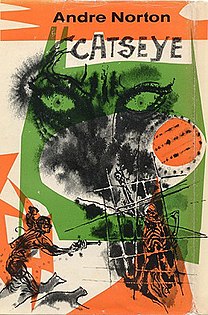 W
WCatseye is a 1961 science fiction novel by American writer Andre Norton. It tells the story of a boy living as a member of the underclass in the "Dipple", a deprived part of a colony on a distant planet, who discovers an ancient secret that changes his life. Catseye is the first of her Dipple series of novels. The other novels in the Dipple series are Judgment on Janus (1963), Night of Masks (1964), and Forerunner Foray (1973).
 W
WThe Crossing (ISBN 0-394-57475-3) is a novel by American author Cormac McCarthy, published in 1994 by Alfred A. Knopf. The story is the second installment of McCarthy's "Border Trilogy".
 W
WThe Deptford Mice is a trilogy of children's dark fantasy novels by British author Robin Jarvis. The first book, The Dark Portal, was published in 1989 by Macdonald & Company in London, followed that same year by The Crystal Prison and then The Final Reckoning in 1990. The trilogy tells the story of a young mouse girl named Audrey Brown and her friends as they fight Jupiter, the evil living god of the sewer rats in the London borough of Deptford.
 W
WDuncton Wood is the first novel by English author William Horwood. It is the first of a six-volume fantasy series of the same name.
 W
WFantastic Mr Fox is a children's novel written by British author Roald Dahl. It was published in 1970, by George Allen & Unwin in the UK and Alfred A. Knopf in the U.S., with illustrations by Donald Chaffin. The first U.K. Puffin paperback, first issued in 1974, featured illustrations by Jill Bennett. Later editions have featured illustrations by Tony Ross (1988) and Quentin Blake (1996). The story is about Mr Fox and how he outwits his farmer neighbours to steal their food from right under their noses. In 2009, it was adapted into a stop-motion animated film by Wes Anderson.
 W
WFire Bringer is a young adult fantasy novel by David Clement-Davies published in 1999, in the United Kingdom and 2000, in the United States. It tells the story of Rannoch, a red deer whose life is the subject of an old prophecy among the deer.
 W
WFlorian: The Emperor's Stallion, also published as Florian: An Emperor's Horse and Florian the Lipizzaner, is a 1933 novel by the Austrian writer Felix Salten, made in 1940 to the film Florian. The novel tells the story of a Lipizzan horse during and after the decline of the Hapsburg monarchy in Vienna, circa 1901–1930.
 W
WThe Fox and the Hound is a 1967 novel written by American novelist Daniel P. Mannix and illustrated by John Schoenherr. It follows the lives of Tod, a red fox raised by a human for the first year of his life, and Copper, a half-bloodhound dog owned by a local hunter, referred to as the Master. After Tod causes the death of the man's favorite hound, man and dog relentlessly hunt the fox, against the dual backdrops of a changing human world and Tod's normal life in hunting for food, seeking a mate, and defending his territory. As preparation for writing the novel, Mannix studied foxes, both tame and wild, a wide variety of hunting techniques, and the ways hounds appear to track foxes, seeking to ensure his characters acted realistically.
 W
WFurther Adventures of Lad, also known as Dog Stories Every Child Should Know, is a 1922 American novel written by Albert Payson Terhune and published by George H. Doran. A follow-up to Lad: A Dog, it contains an additional eleven short stories featuring a fictional version of Terhune's real-life rough collie Lad, including the stories of Lad's initial arrival at the "Place", the death of his mate, and the day of his own death. Most of the stories were originally published in various magazines, and touch on themes of justice and the concepts of right and wrong. Terhune notes that he decided to publish the novel due to numerous letters received in response to the first novel, and the thousands of visitors who came to Sunnybank to visit the real-life Lad's grave. Though he initially intended for Further Adventures of Lad to be the final book of Lad stories, he would eventually publish one more book of stories, Lad of Sunnybank, in 1929.
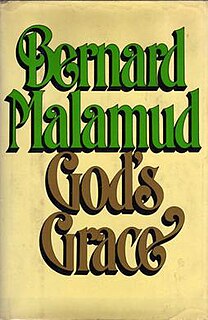 W
WGod's Grace is the final novel written by American author Bernard Malamud, published in 1982 by Farrar, Straus and Giroux. The novel focuses on Calvin Cohn, the supposed sole survivor of thermonuclear war and God's second Flood, who attempts to rebuild and perfect civilization amongst the primates that make their way onto a tropical island.
 W
WThe Metamorphoses of Apuleius, which Augustine of Hippo referred to as The Golden Ass, is the only ancient Roman novel in Latin to survive in its entirety.
 W
WGreyfriars Bobby is a 1912 novel by Eleanor Atkinson based on the true story of the dog Greyfriars Bobby. The novel has been adapted into two films: Challenge to Lassie and Greyfriars Bobby. Both films starred Donald Crisp. The 1961 Walt Disney film Greyfriars Bobby: The True Story of a Dog was also based on this book. This novel is written from the point-of-view of the dog, Bobby, and uses Scottish dialogue as the novel is set in Edinburgh, Scotland.
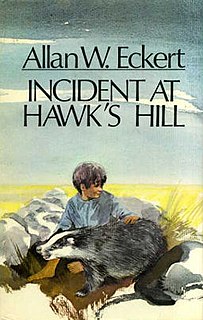 W
WIncident at Hawk's Hill is a Newbery Honor book by naturalist and writer Allan W. Eckert published in 1971. Supposedly based on a true event, it is a historical novel centering on a six-year-old boy who gets lost on the Canadian prairie and survives for two months thanks to a mother badger. Though the Newbery is an award for children's literature, Incident at Hawk's Hill was originally published as an adult novel. It was a Reader's Digest selection. It was also an American Library Association Notable book.
 W
WJaws is a 1974 novel by American writer Peter Benchley. It tells the story of a great white shark that preys upon a small resort town and the voyage of three men trying to kill it. The novel grew out of Benchley's interest in shark attacks after he learned about the exploits of Montauk, New York shark fisherman Frank Mundus in 1964. Doubleday commissioned him to write the novel in 1971, a period when Benchley worked as a freelance journalist.
Jennie is a novel by American author Douglas Preston. The book was published on October 1, 1994 by St. Martin's Press.
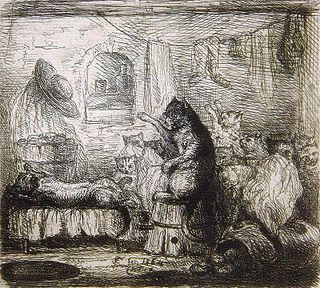 W
WThe Life and Opinions of the Tomcat Murr together with a fragmentary Biography of Kapellmeister Johannes Kreisler on Random Sheets of Waste Paper is a complex satirical novel by Prussian Romantic-era author E. T. A. Hoffmann. It was first published in 1819–1821 as Lebens-Ansichten des Katers Murr nebst fragmentarischer Biographie des Kapellmeisters Johannes Kreisler in zufälligen Makulaturblättern, in two volumes. A planned third volume was never completed. It was Hoffmann's final novel and is considered his masterpiece. It reflected his concepts of aesthetics, and predated post-modern literary techniques in its unusual structure. Critic Alex Ross writes of the novel, "If the phantasmagoric 'Kater Murr' were published tomorrow as the work of a young Brooklyn hipster, it might be hailed as a tour de force of postmodern fiction."
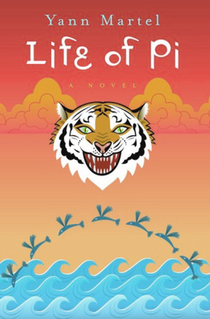 W
WLife of Pi is a Canadian philosophical novel by Yann Martel published in 2001. The protagonist is Piscine Molitor "Pi" Patel, an Indian Tamil boy from Pondicherry who explores issues of spirituality and metaphysics from an early age. He survives 227 days after a shipwreck while stranded on a lifeboat in the Pacific Ocean with a Bengal tiger which raises questions about the nature of reality and how it is perceived and told.
 W
WLobster is a French novella by Guillaume Lecasble. It was published in Paris by Les Éditions du Seuil in 2003, and has been translated into English and Spanish.
 W
WThe Longest Whale Song is a children's book by Jacqueline Wilson.
 W
WMan-Shy (1931) is a novel by Australian author Frank Dalby Davison. It won the ALS Gold Medal for Best Novel in 1931.
 W
WMasha, or the Fourth Reich is a dystopian novel by Lithuanian/Ukrainian author Jaroslav Melnik. Published in 2013 in Lithuanian by the largest publishing house company group in the Baltic states Alma littera, it was shortlisted for the Book of the Year Awards. 18 reviews have been published about this novel. Critics call this thriller ‘a shocking book that can be a bestseller in Western countries’. ‘In this book the author fulfilled Hitler's dream’. In 2016 the novel was published in Ukraine and became a bestseller. In 2020, the novel was published in France by Actes Sud.
 W
WAnna Maria Geertruida "Annie" Schmidt was a Dutch writer. She is called the mother of the Dutch theatrical song, and the queen of Dutch children's literature, praised for her "delicious Dutch idiom," and considered one of the greatest Dutch writers. An ultimate honour was extended to her posthumously, in 2007, when a group of Dutch historians compiled the "Canon of Dutch History" and included Schmidt, alongside national icons such as Vincent van Gogh and Anne Frank.
 W
WMonkey Shines is a 1983 British psychological horror novel by Michael Stewart. Its plot follows a quadriplegic man whose service animal, a capuchin monkey named Ella, grows increasingly violent. It was adapted into a feature film of the same name in 1988 by director George A. Romero.
 W
WMus of Kerbridge is a 1995 fantasy novel by Paul Kidd. It follows the story of a mouse called Mus who has been sent to spy on the princess of Kerbridge only to help her fight against the warlady of the South. It is set in the same world detailed in the Lace & Steel RPG.
 W
WThe Old Man and the Sea is a short novel written by the American author Ernest Hemingway in 1951 in Cayo Blanco (Cuba), and published in 1952. It was the last major work of fiction written by Hemingway that was published during his lifetime. One of his most famous works, it tells the story of Santiago, an aging Cuban fisherman who struggles with a giant marlin far out in the Gulf Stream off the coast of Cuba.
 W
WPerri: The Youth of a Squirrel is a 1938 novel by Felix Salten, author of the 1923 novel Bambi, a Life in the Woods, and is a followup to that book. Its title character is a Eurasian red squirrel. Bambi makes a brief appearance in Perri.
 W
WSirius is a 1944 science fiction novel by the British philosopher and author Olaf Stapledon, whose title character is a dog named Sirius with humanlike intelligence. A sense of existential questioning suffuses the book, as the author delves into aspects of Sirius's psyche. The novel deals with many human issues through Sirius and his experiences, his unusual nature, his ideas and his relationships with humans. The characters go to great lengths to prevent Sirius from becoming a circus-type wonderdog, and instead, they seek to develop Sirius's character much like a family would create and foster that of a human child.
 W
WTarka the Otter: His Joyful Water-Life and Death in the Country of the Two Rivers is a novel by Henry Williamson, first published in 1927 by G.P. Putnam's Sons with an introduction by the Hon. Sir John Fortescue. It won the Hawthornden Prize in 1928, and has never been out of print since its first publication.
 W
WThree Bags Full: A Sheep Detective Story is 2005 novel by Leonie Swann. It is a detective story featuring a flock of anthropomorphic Irish sheep out to solve the murder of their shepherd. Written originally in German, the novel became an international bestseller, and has been translated into more than 30 languages.
 W
WTimbuktu is a 1999 novella by Paul Auster. It is about the life of a dog, Mr Bones, who is struggling to come to terms with the fact that his homeless master is dying.
 W
W"The Ugly Duckling" is a Danish literary fairy tale by Danish poet and author Hans Christian Andersen (1805–1875). It was first published on 11 November 1843 in New Fairy Tales. First Volume. First Collection, with three other tales by Andersen in Copenhagen, Denmark to great critical acclaim. The tale has been adapted to various media including opera, musical, and animated film. The tale is an original story by Andersen.
 W
WWe Are All Completely Beside Ourselves is a 2013 novel by the American writer Karen Joy Fowler. The novel won the 2014 PEN/Faulkner Award for Fiction and was also short-listed for the 2014 Man Booker Prize.
 W
WThe Yearling is a novel by Marjorie Kinnan Rawlings published in March 1938. It was the main selection of the Book of the Month Club in April 1938. It was the best-selling novel in America in 1938 and the seventh-best in 1939. It sold over 250,000 copies in 1938. It has been translated into Spanish, Chinese, French, Japanese, German, Italian, Russian and 22 other languages. It won the 1939 Pulitzer Prize for the Novel.